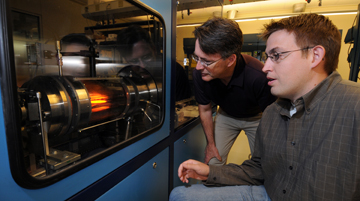Discovery Park turns 10

Timothy Sands (left), Purdue provost and researcher, and graduate student Mark Oliver operate a "reactor" in a Discovery Park lab in the Birck Nanotechnology Center for a project aimed at perfecting solid-state lighting. The technology could cut electricity consumption by 10 percent if widely adopted. (Purdue News Service photo)
Discovery Park, Purdue's internationally recognized hub of interdisciplinary innovation directed at global challenges, is celebrating its 10th anniversary this academic year. In addition to revolutionizing what is known -- in areas from nanotechnology to learning in the STEM disciplines -- the park has shifted how researchers pursue and create knowledge.
"While Discovery Park didn't invent the role that collaboration can play in addressing the major problems of the world, it has helped to create more integrated research at Purdue," says Alan Rebar, senior associate vice president for research and executive director of Discovery Park. "Not only is Discovery Park changing how research is conducted, it's changing how Purdue collaborates regionally, nationally and globally with industry, agencies, foundations and other universities -- all with the goal to make the world a better place."
From its roots in 2001, when it was launched with a $5 million commitment from the state of Indiana for a nanotechnology center and a gift of $26 million from the Lilly Endowment, Discovery Park has grown to a $750 million research and learning complex of eight core centers housed in five facilities on the west edge of campus.
Discovery Park now engages more than 4,000 faculty members and students in research that ranges from curing cancer to forging a competitive edge for Indiana manufacturers. It also has helped Purdue establish stronger relationships with universities and institutions from around the world -- from countries including Russia, India, Australia, China, Japan, Singapore, South Korea, and Colombia. In addition to serving faculty, Discovery Park plays a key role in fostering innovation among students.
Shaili Sharma, who expects to complete a doctorate in biomedical engineering in December, was a Purdue Realization and Entrepreneurship Program (PREPP) fellow at Discovery Park's Burton D. Morgan Center for Entrepreneurship, an experience that she said allowed her to explore the commercialization aspects of her dissertation research.
"I got the opportunity to interact with several people pertinent to medical device commercialization and learned vastly from this exposure," she says. "The opportunity also made me greatly appreciate the potential impact of my work. After graduate school, I hope to continue working on translational research projects, working to bring solutions to unmet clinical needs."
With its state-of-the-art facilities, laboratories and instrumentation, Discovery Park has generated $600 million in sponsored program funding and more than $250 million in gifts from donors and foundations and other supporters. Today, it operates as a self-sustaining entity.
"Discovery Park is a tremendous asset to the University's research enterprise," says Richard Buckius, vice president for research. "Interdisciplinary research has become the norm when it comes to addressing grand challenge problems, and Discovery Park is well-recognized for its superior collaborative environment. The atmosphere generated by Purdue faculty and staff has proven to be a key ingredient to the self-sustaining research capabilities at Discovery Park."
Discovery Park's interdisciplinary research efforts are being celebrated throughout April with a series of co-sponsored lectures focused on entrepreneurship, conservation and addressing challenging global problems through innovation. As part of the celebration, Laurie Marker, founder and executive director of the Cheetah Conservation Fund, will present "A Race to the Future to Save the Wild Cheetah" at 12:30 p.m. Friday (April 27) in Lynn Hall, Room 1136. Sponsors are the Purdue College of Veterinary Medicine, Discovery Park and the Lilly Endowment.
Discovery Park
* Advanced Computational Center for Engineering and Sciences (Cyber Center, Computing Research Institute and the Rosen Center for Advanced Computing in ITaP)
* Bindley Bioscience Center (construction of an expansion to house the Multidisciplinary Cancer Research Facility is to begin soon and is expected to be completed in 2013)
* Birck Nanotechnology Center
* Burton D. Morgan Center for Entrepreneurship
* Discovery Learning Research Center
* Global Sustainability Initiative (Center for the Environment, Energy Center, Purdue Climate Change Research Center and the Center for Global Food Security)
* Oncological Sciences Center
* Regenstrief Center for Healthcare Engineering
Buildings (building costs)
* Birck Nanotechnology Center ($58 million)
* Bindley Bioscience Center ($15 million)
* Burton D. Morgan Entrepreneurship Center ($7 million)
* Gerald D. and Edna E. Mann Hall ($12 million)
* Hall for Discovery and Learning Research ($25 million)
